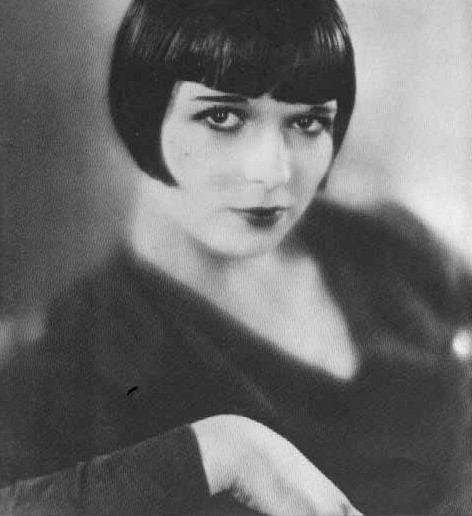Actress of potent sexuality Anonimo ("The Times", August 10, 1985) |
Louise Brooks, regarded by several authorities as one of the finest film actresses of the silent era, died on August 8 at the age of 78.
She was a star for barely five years and her reputation rests almost entirely on two films she made in Germany in late 1920s,
Pandora's box and Diary of a lost girl.
At the time, her performances made only a moderate impact, her career went into a rapid decline and for nearly 20 years she was virtually
forgotten. Then, in the 1950s, she was rediscovered by a younger generation of film historians and quickly became a cult figure.
Kevin
Brownlow, the British film maker and an expert of the silent period, called her "an actress of brilliance, a luminescent personality and a beauty unparalleled in film history".
She was born in
Cherryvale, Kansas, in 1906, the daughter of a lawyer. Showing an early talent for dancing. She left school at 15 and went to New York where she joined one of the
America's leading company, the Denishawn Dancers. A fellow dancer was Martha
Graham.
Dismissed in 1924 for "lacking sense of vocation", she danced in George White's
Scandal[s], performed the charleston at the Café Paris in London and on returning to New York was offered work by
Ziegfeld, appearing in his 1925 Follies with Will Rogers and W. C.
Fields. |
|

|
|
She made her film debut the same year, with a bit part in The street of forgotten men, and signed a contract with Paramount. During 1926 she made six pictures, mainly sophisticated comedies in which the studio specialised. They included The American Venus, in which she played a bathing beauty, and It's the old Army game, which helped to launch the film career of W. C. Fields and was directed by Eddie Sutherland, to whom she was briefly married though still only 20and with no formal training as an actress, she soon made her mark; already she was fashioning the screen image by which she would be remembered, the black bobbed dark hair and glowing white
skin.
In 1928 she was lent by Fox for the film which changed the course of her career, A girl in every port, directed by the young Howard Hawks, and featuring Brooks as a femme fatale exercising her sexual power over Victor McLaglen and Robert
Armstrong.
The film was seen by the German director G. W.
Pabst, looking to cast a not dissimilar part, that of Lulu, in two Wedekind plays he was bringing to the screen under the title of Pandora's box.
By now Brooks was in dispute with Paramount over money and when Pabst offered her the job, in preference to another [riching] actress, Marlene Dietrich, she sailed for Germany. Pandora's box, the story of a free living girl of destroys a succession of men with her sexual attraction and finally gets her comeuppance from Jack the Ripper, drew from Brooks a performance which was the more telling for not being obviously
flamboyant.
Her second film for Pabst, Diary of a lost girl, was again perfectly suited to her ability to convey a potent sexuality. Condemned to a reformatory after she has been raped and made pregnant, the 16 year old heroine finds a sort of freedom in becoming a prostitute before her eventual redemption; not surprisingly, perhaps, the film was heavily censored on its initial release and attention was directed more on its subversive theme than to Brooks' performance.
She than made a film in Paris, Prix de beauté
- her first talking
picture, though her voice was dubbed - and in 1930 returned to Hollywood. But far from building on the success of the Pabst
pic, the rest of her career was a sad anti - climax. |
Her last film, made in 1938, was a B - western, Overland stage raiders, with the then little - known John
Wayne.
Lost to the cinema at the age of only 32, she ran a dance studio in her native Kansas, did radio work and publicity in New York and became a shop assistant at Saks Fifth
Avenue. By the mid of 1950s she was near to destitution and a group of her old friends clubbed together to provide her with financial
means.
She was sustained too by a renewed interest in her
films. In 1958 the Cinemateque of Paris ran a retrospective of her work and she made a triumphant personal appearance. Among those present was the director Jean Luc Godard, who was to pay homage in his film, Vivre sa vie, by giving the heroine the Louise Brooks "black helmet" hairstyle. Her last public appearance was at the screening of Prix de beauté in New York in 1960.
By this time she was living alone in a modest house in
Rochester, when she was bedridden with osteoarthritis. Since many of her films had been
lost, her career remained something of an enigma but clues to it emerged in interviews she gave and in a series of perceptive and astringent articles she contribueted to film mags on both her own life and work and that of contemporaries like
Fields, Charlie Chaplin, Bogart and Garbo. In 1982 she published Lulu in Hollywood, a collection of essays on her life. |
